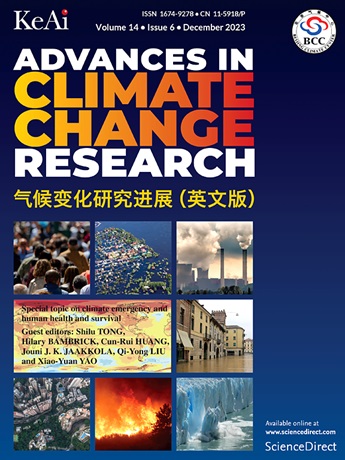在活性层氧化盛行的同时,多年冻土产生更多CH4:来自东北森林-湿地交错带的见解
IF 5.2
1区 地球科学
Q1 ENVIRONMENTAL SCIENCES
引用次数: 0
摘要
持续的气候变暖导致更深的活动层和增加的CH4排放。然而,我们对活性层和永久冻土中CH4生成和氧化电位的了解仍然有限。本研究探讨了大兴安岭两种不同生境下各层CH4生成和氧化电位及其对温度变化的响应。结果表明,多年冻土的CH4生产潜力高于森林和湿地生境的活动层(p <;0.05)。活土层的温度敏感性(森林为1.98±0.20,湿地为3.42±0.37)高于多年冻土(森林为1.59±0.13,湿地为2.08±0.34)。活性层的CH4氧化电位高于多年冻土(p <;0.05)。冻土层的温度敏感性(森林为3.65±0.76,湿地为2.62±0.50)高于活土层(森林为3.46±0.66,湿地为1.90±0.32)。驱动这些过程的关键非生物因素是pH和土壤含水量。在微生物特性中,CH4的产生受mcrA基因丰度和产甲烷多样性的影响,而不是受群落组成的影响。相反,CH4氧化受pmoA基因丰度、甲烷营养多样性和群落组成的影响。土壤参数和微生物因子分别占CH4产量变异的78%和CH4氧化势变异的60%。总体而言,本研究强调了森林-湿地交错带活土层和多年冻土中CH4的不同生成和氧化电位及其控制因素。这些发现强调了在模拟气候变暖下永久冻土层温室气体排放时考虑活土层变化的重要性。本文章由计算机程序翻译,如有差异,请以英文原文为准。
Higher CH4 production in permafrost while oxidation prevails in the active layer: Insights from a forest‒wetland ecotone in Northeast China
Continuous climate warming results in a deeper active layer and elevated CH4 emissions. However, our knowledge about the CH4 production and oxidation potentials in active layers and permafrost remains limited. This study explored the CH4 production and oxidation potentials in these layers and their responses to temperature variations across two habitats in the Da Xing'an Mountains in northeast China. The results showed that the CH4 production potential was higher in permafrost than in the active layer across forest and wetland habitats (p < 0.05). The temperature sensitivity was greater in the active layer (1.98 ± 0.20 in forests, 3.42 ± 0.37 in wetlands) than in permafrost (1.59 ± 0.13 in forests, 2.08 ± 0.34 in wetlands). CH4 oxidation potential was higher in the active layer than in permafrost (p < 0.05). However, its temperature sensitivity was higher in permafrost (3.65 ± 0.76 in forests, 2.62 ± 0.50 in wetlands) than in the active layer (3.46 ± 0.66 in forests, 1.90 ± 0.32 in wetlands). The key abiotic driving these processes were pH and soil water content. Amongst microbial properties, CH4 production was enhanced by the abundance of mcrA genes and methanogenic diversity rather than by community composition. On the contrary, CH4 oxidation was influenced by pmoA gene abundance, methanotrophic diversity and community composition. Soil parameters and microbial factors accounted for 78% of the variance in CH4 production and 60% in CH4 oxidation potential. Overall, this study highlights the different production and oxidation potentials of CH4 in the active layer and permafrost within a forest‒wetland ecotone, as well as their controlling factors. These findings emphasise the importance of considering changes in the active layer when modelling greenhouse gas emissions from permafrost regions under a warming climate.
求助全文
通过发布文献求助,成功后即可免费获取论文全文。
去求助
来源期刊

Advances in Climate Change Research
Earth and Planetary Sciences-Atmospheric Science
CiteScore
9.80
自引率
4.10%
发文量
424
审稿时长
107 days
期刊介绍:
Advances in Climate Change Research publishes scientific research and analyses on climate change and the interactions of climate change with society. This journal encompasses basic science and economic, social, and policy research, including studies on mitigation and adaptation to climate change.
Advances in Climate Change Research attempts to promote research in climate change and provide an impetus for the application of research achievements in numerous aspects, such as socioeconomic sustainable development, responses to the adaptation and mitigation of climate change, diplomatic negotiations of climate and environment policies, and the protection and exploitation of natural resources.
 求助内容:
求助内容: 应助结果提醒方式:
应助结果提醒方式:


